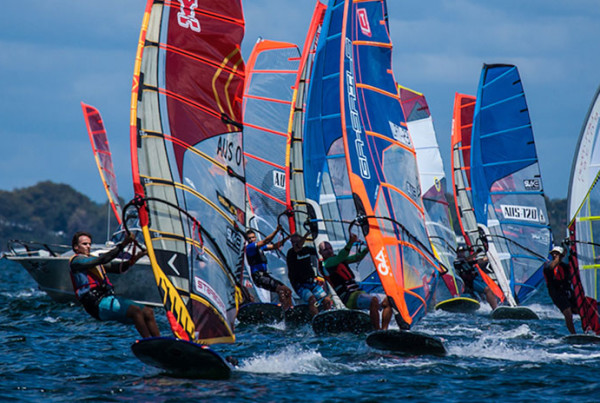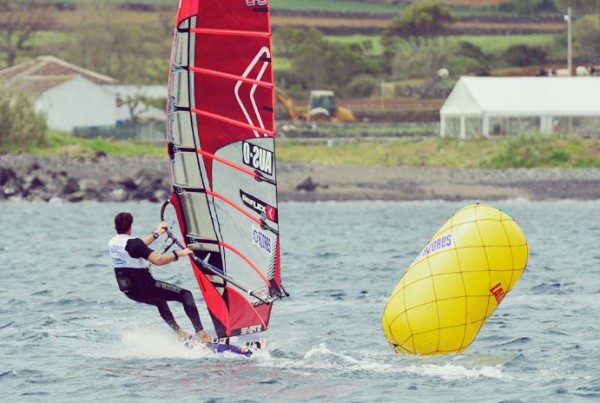In the early stages of formula racing you may be on a steady learning curve. You improve the trim/tuning of your equipment and you gain confidence in sailing around a race course and applying the tactics you have learnt through experience. And then suddenly it happens… You have arrived at the mystical learning plateau. Most sailors that have seen this happening to them begin to get a little frustrated because they are at a loss at how to improve their speed around the course any further. Some have money to spend and start buying all kinds of new gear, hoping that this will help them improve and others (heaven forbid) start critisising the formula format for being to hard. Either way it appears to be a factor in many sailor’s decision to stop competing in this great game of FW racing. Personally speaking, you yourself have not given up yet because you are reading this to improve right? Dutch windsurfer Jan Witteveen (NED-22) gives us this article outlining some simple aspects of your sailing you can work on to improve your speed around the course and climb off the learning plateau you’ve just reached.
Jan Witteveen has been racing formula since it began and has been a Dutch Champion in windsurfing way back in the Div II days before some of us were even old enough to hold an uphaul. He’s now heavily involved with organising the popular Regio Cup racing events in the Netherlands and an avid FW racer…
Let’s take a step back from your sailing and see what is happening on the learning plateau. All the big, early improvements have already happened for you. You are not making the really big tactical mistakes on the course anymore; your equipment trim is basically ok, as is your ability to sail around the course without dropping the sail. Now it is time to see what is holding you back and why you are on this plateau. There may be a number of reasons but from what I have seen in the past 20 years of competing it is mainly in the way we all going about our training. Most go straight to the water and begin sailing. Maybe tweak to some extent your downhaul and change a fin, but realistically, at the end of the day a couple of up and downwind sessions is all you have accomplished as has been the way with most previous training sessions. You need to step out of this groove and start thinking about what you need to improve on and get your training on to a new path…
In this article we will look at a common reason for being stuck on the learning plateau: when your technical skills are holding back further improvements.
Are you able to tack and initiate planing upwind quickly and effectively out of each tack? So that you can get out of dirty air and not find yourself in the hopeless position? Are you able to gybe your board and keep it on the plane even in marginal conditions? If not, stop and think briefly about some moments out on the racecourse where the leaders of the fleet are going through their manouvres. Whats the difference between the top guys and yourself? A really good manouvre can get you at least 10-20 meters closer/faster to the finish then a normal executed manouvre. Just imagine that your manouvres are not even on par with normal ?? Typically you may tack 4 times in a race. If you are 5 seconds slower than someone else in your tacks then you’ve already lost 20 seconds. A formula board travels at 8m/sec in medium winds. That means you’ve just lost 160m around the racecourse. Is that how much they are beating you by? Thought so…
The big question now is how to improve then?
- First look at your technique (tacking and gybing)
- Then work on this technique in your training sessions so you become used to how it is done correctly and fluently
- Then start training the technique under pressure against other sailors
Mastering Technique (hands are your friends):
A major mistake I often see in tacking and gybing is the way the boom is handled. The handwork is the most important aspect in both the tack and gybe manoeuvre. Most sailors perform their footwork very well but their handwork is so bad that they lose a lot of efficiency in these manoeuvres.
First lets focus on tacking [Fig 1]. The first thing to work on is bringing your backhand a little further to the back of the boom so you can sheet in very aggressively when initiating the tack [Fig 2]. Tacking should be AGGRESSIVE. With your hands further down the boom you can oversheet more easily and quickly force the board direction into the wind. With your feet you are first coming out of the back strap to help the board pointing into the wind and getting ready to move to the other side of the sail. As soon as the board is far enough into the wind (that the sails feels very light in your hands) and you are getting ready to jump to the other side of the sail, move your front hand to the very front of the boom [Fig 3] near the mast (on the SAME side as you are currently sailing on). This step seems to be missed often by sailors who don’t tack very well.
You should have a very wide grip at this moment, giving you a lot of control. Your front hand is right at the front of the boom and your back hand a long way back somewhere behind your harness lines. When you make the jump to the other side of the sail with your body, let go of your backhand first and cross over to the other side of the boom with your back hand. In the process of doing this, with large sails you can actually use your front hand to begin pulling the sail towards you and more upright [Fig 4] (notice I am pulling hard with my right hand in Fig 4).
As you jump around the sail, with your back hand, grab the boom at the front on the new side of the sail [Fig 5]. At this point the sail will most likely still be raked back from pointing so hard to windward to go into the tack. Use your new front hand to aggressively pull the sail back to the upright position and begin to reach back to a wide position with your backhand on the new side of the boom [Fig 5]. Now on the other side of your sail your new forward foot is as close to the mast as possible and your back foot is in front of the back straps but more towards the rail of the board than the centre. Try to grab the boom as far back as possible to get a powerful grip and lower your centre of effort by bending your knees a little [Fig 6]. Start pushing the board downwind wind to get ready to pump and into the new wind.
Push the board aggressively. Punish it. Hard. HARDER. Use your back foot to pull towards you and your front foot to push off downwind, forcing the board quickly into a beamreach position which will allow you to start pumping and get up to speed. As you start to pump you can manoeuvre your feet into the footstraps (wind strength will define how quickly you get into the straps – the windier it is, the quicker you want to be safe inside them).
Job done. Now you are cruising back upwind on the next tack. Relax and think what you’ve just done over before trying the exercise again.
The best way to train tacking/gybing is simply to drill it into yourself. Repeat this tacking sequence over and over in your head, visualising all the steps while you imagine and feel that you are perfroming it live. Do it on the water as well as in your chair in front of the TV. Practice the technique constantly. It is likely that you may first be worse on the tacks before you start to improve significantly. After practice the “training phase” must start. At best this can be done in pairs or a with a group:
Training Phase:
In your group (or pair) of sailing partners, one of the group is the leader. The leader decides when to tack by shouting “TACK” or any other signal for that matter. You all agree on this signal to tack immediately. You all need to get as quickly upwind as possible by performing quick and effective tack techniques. Be sure to make really short upwind legs before tacking again. The goal for everyone who takes part is to get as far upwind as possible and to tack faster than the boats around you. After twenty or so tacks you can stop and see who has won this leg. Really push yourself to perform the best tacks you can. By pushing hard you train in the same frame of mind (and exhaustion state) as if you are in a real race. Then sail downwind and start the sequence again with another leader. If you are lucky enough to not sail alone this is great for improving your tacks/gybing and in itself is also great for your windsurf endurance and strength.
- Extra Tip: If possible, it would be very beneficial to get your tacking/gybing technique on film so that you can examine and critique your technique afterwards.
This is really what learning and improving is about. Just give it a try. It may help you find those extra seconds around the course and find a new way to improve your racing – climbing off that learning plateau that has been punishing you and your motivation this season.
Next article I will talk about gybing to complete this series about handling the boom. Have some great TOW.
Jan Witteveen.








